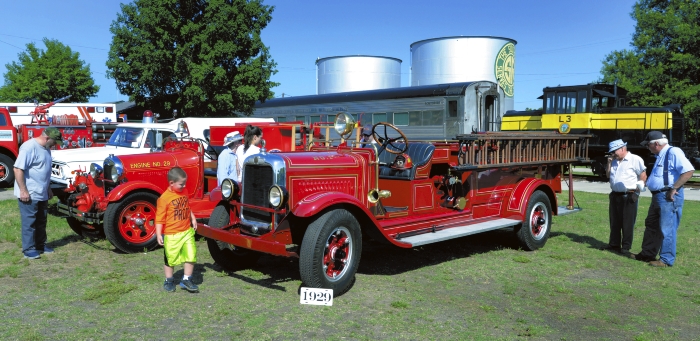Firetrucks featured at NC Transportation Museum show
Published 12:05 am Monday, June 15, 2015

- A young boy looks over the restored 1929 American LaFrance firetruck that belongs to the China Grove Fire Department at the NC Transportation Museum's first Firetruck Show. photo by Wayne Hinshaw, for the Salisbury Post
By Wayne Hinshaw
For the Salisbury Post
“We’ve got firetrucks, firetrucks and more firetrucks,” explained Michelle Comer, an employee at the NC Transportation Museum. That was how Comer described the agenda for the day at the museum’s first ever firetruck show.
As part of the effort to have ongoing events at the museum, Comer said June Hall and volunteer Chasity Young came up with the idea for the show. Young is a firefighter with the Ellis Volunteer Fire Department and had contacts with other fire departments.
The show had 25-30 firetrucks plus a Rowan EMS ambulance, Rowan Rescue Squad vehicles, the Salisbury Fire Department Smoke House. The N.C. Forest Service also flew in a helicopter used for fighting forest fires.
The landing of the yellow helicopter was the biggest excitement of the day. With dust flying everywhere from the wind generated by the twirling rotor blades, the chopper’s arrival could not be missed.
It was a great day for children to see the trucks and helicopter and sit in the seats of the big machines. It was also a great day for adults interested in firefighting equipment to see what the local departments had to show and talk shop.
David Watson, from the Ellis Department, presented a history of the fire service. According to Watson, Ben Franklin is credited with the idea of the first volunteer fire service in 1736 in Philadelphia. Fire coverage was offered using a horse-drawn wagon with leather fire buckets. In North Carolina, the city of New Bern started the first volunteer department in 1773. Wilmington had the first paid firefighters in 1897. The red color paint was first used on fire vehicles because it was considered the “very best” since red paint was the most expensive.
Ellis Fire Chief Jeff Whitley described the start of rural fire service in Rowan County. There were no volunteer fire departments in Rowan County before 1951. “If you had a fire, you were on your own,” Whitley said. “Most of the time the property was totally destroyed.”
Insurance companies actually led the push for volunteer fire departments in the county. The companies couldn’t or wouldn’t insurance homes if there were no fire departments. Salisbury city had fire coverage starting in 1877, but it stopped at the city limits.
South Salisbury was the first Rowan volunteer department, starting in 1951 a few months after two children were lost in a house fire.
Shortly after South Salisbury formed, Ellis and Franklin departments were established.
Laughing as he told the story, Whitley said that he has been told by some old Southern Railway Spencer Shop workers that the railroad shop workers built a couple of firetrucks for Ellis and Woodleaf. He said he didn’t think the railroad wanted to be in the firetruck business.
Many of the Rowan departments had current modern firetrucks on display, along with an assortment of antique and restored fire trucks. The most eye- catching restored truck was a 1965 Seagrave Anniversary Series truck from Marshville in Union County. The big truck was painted red and black with the front being almost all chrome.
Whitley said there was a lot of chrome to keep polished.
China Grove’s 1929 American LaFrance truck was parked next to the Museum’s Ford engine #29 and W.A. Brown’s 1914 American LaFrance pumper. Troy Volunteer Fire Department, in Montgomery County, displayed its 1973 Mack truck. That is not Troy’s main equipment any longer, but it is still in service if needed. The driver laughed, saying that “You almost need two men to steer that thing out on the road.”
The show included a rare piece of firefighting equipment history, Ron Herion’s “Chemical Fire Engine” dating from the 1800s. Herion purchased the engine off eBay and has had difficulty gathering information about the American LaFrance equipment. It has tall wooden wheels and a tank for water. It had no pump, but the water was forced from the tank by a chemical reaction pushing the water out of the hose.
Cleveland Community Fire Department Chief Kenny Payne displayed two hand-pulled “hose carts” from his personal collection. The two-wheeled carts used for carrying hose were pulled by men running to a fire. One cart was manufactured in 1886 and the other 1906.
The show ended with a parade of firetrucks around the museum grounds.


